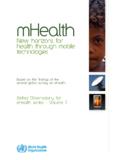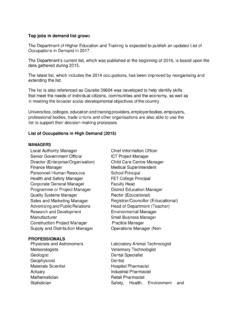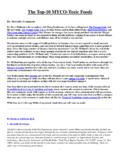Transcription of HEALTH-BASED TARGETS - World Health Organization
1 HEALTH-BASED TARGETS1. Role of HEALTH-BASED targetsHealth- based TARGETS are measurable Health , water quality, or performance objectives that are established based on a judgement of safety and on risk assessments of waterborne hazards. The Guidelines for Drinking-water Quality (the Guidelines) describe four distinct types of HEALTH-BASED TARGETS , applicable to all types of hazards and water supplies: Health outcome TARGETS ( tolerable burdens of disease); water quality TARGETS ( guideline values for chemical hazards); performance TARGETS ( log-reductions of specifi c pathogens); and specifi ed technology TARGETS ( application of defi ned treatment processes).
2 These TARGETS are common components of existing drinking-water guidelines or standards that are used to protect and improve drinking-water quality and consequently, human Health . They provide benchmarks for water suppliers and regulators to confi rm the adequacy of existing systems or the need for improvement. They underpin the development of WSPs and verifi cation of successful implementation. Where required, HEALTH-BASED TARGETS can be used to support incremental improvement by marking out milestones to guide progress towards water safety and public Health goals.
3 This normally requires periodic review and updating of priorities and TARGETS . In turn, norms and standards should also be periodically updated. HEALTH-BASED TARGETS should assist in determining specifi c interventions appropriate to delivering safe drinking-water, including control measures such as source protection and treatment Se ing HEALTH-BASED targetsThe use of HEALTH-BASED TARGETS is applicable in countries at all levels of development. To ensure effective Health protection and improvement, TARGETS need to be realistic, measurable, based on scientifi c data and relevant to local conditions (including economic, environmental, social and cultural conditions) and fi nancial, technical and institutional resources.
4 HEALTH-BASED TARGETS should be part of an overall public Health policy, taking into account public Health status and trends and the contribution of drinking-water to the transmission of infectious disease and to overall exposure to hazardous chemicals both in individual settings and within overall Health management.> 1 The judgement of safety or what is a tolerable burden of disease in particular circumstances is a matter in which society as a whole has a role to play. The fi nal judgement as to whether the benefi t resulting from the adoption of any of the HEALTH-BASED TARGETS justifi es the cost is for each country to water can be a source of microbial, chemical or radiological hazards, it is by no means the only source.
5 In setting TARGETS , consideration needs to be given to other sources, including food, air, person-to-person contact, consumer products, as well as poor sanitation and personal hygiene. Where the overall burden of disease from multiple exposure routes is very high, there is limited value in setting strict TARGETS for drinking water. For example there is limited value in establishing a strict target for a chemical hazard if drinking-water provides only a small proportion of total exposure. The cost of meeting such TARGETS could unnecessarily divert funding from other, more pressing Health interventions and is not consistent with the public Health objective of reducing overall levels of risk from all sources of exposure to environmental is also important to take account the impact of the proposed intervention on overall rates of disease.
6 For some pathogens and their associated diseases, interventions in water quality may be ineffective and may therefore not be justifi ed. This may be the case where other routes of exposure dominate. For others, long experience has shown the effectiveness of improving drinking-water supply and quality management ( , typhoid, dysentery caused by Shigella). Meeting HEALTH-BASED TARGETS should be viewed in the context of broader public Health policy including initiatives to improve sanitation, waste disposal, personal hygiene and public education on ways to reduce both personal exposure to hazards and reducing impacts of personal activity on water resources.
7 Improved public Health , reduced carriage of pathogens and reduced human impacts on water resources all contribute to drinking-water safety. Public Health prioritization would normally indicate that the major contributors to disease should be dealt with preferentially taking account of the costs and impacts of potential interventions. However, this does not mean ignoring lesser TARGETS if they can be easily achieved for little cost, as long as this does not divert attention from major important concept in the allocation of resources to improving drinking-water safety is the possibility of establishing less stringent transitional TARGETS supported by sound risk management systems in order to encourage incremental improvements to the quality of drinking-water.
8 In this regard, HEALTH-BASED TARGETS can be used as the basis for supporting and measuring incremental progress in water quality. Improvements can relate to progression through increasingly tighter TARGETS or evolution through target types that more precisely refl ect the Health protection goals ( from specifi ed technology TARGETS to performance TARGETS ). The processes of formulating, implementing, communicating and evaluating HEALTH-BASED TARGETS provide benefi ts to the overall preventive management of drinking-water quality.
9 These benefi ts are outlined in Table 1. 3. Disability adjusted life years (DALYs), tolerable disease burden and reference level of riskAt a national level, decisions about risk acceptance and tolerable burdens of disease are complex and need to take account of the probability and severity of impact in addition to the environmental, social, cultural, economic and political dimensions that play important roles in decision-making. Negotiations play an important role in these processes, and the outcome may very well be unique in each situation.
10 Notwithstanding the complexity of these decisions, defi nitions of tolerable burdens of disease and reference levels of risk are required to provide a baseline for the development of HEALTH-BASED TARGETS and as a departure point for decisions in specifi c situations.> 2 Descriptions of tolerable burdens of disease relating to water are typically expressed in terms of specifi c Health outcomes such as maximum frequencies of diarrhoeal disease or cancer incidence. However, these descriptions do not consider the severity of the outcomes.
















